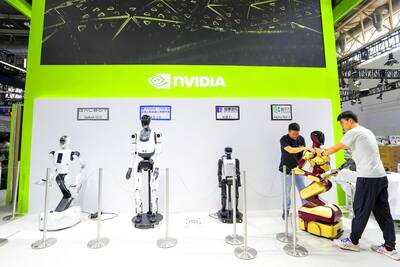A smartphone battery that lasts longer than a day might be out of reach for most people for the moment, but a large one that charges to 48 percent in five minutes is on the way.
Huawei Technologies Co’s (華為) new fast-charging battery is capable of charging 10 times faster than normal lithium-ion batteries and uses a new electrode design, the company said.
The batteries were developed by the Huawei-owned Watt Lab and were demonstrated at the 56th Battery Symposium in Japan last week.
The new batteries have a catalyst built into the anode that speeds up the conversion of electrical energy from the grid into chemical energy without shortening the battery’s life or reducing the amount of energy it can store.
Two types of batteries were on show: one 3 ampere-hour (Ah) battery that could be charged to 48 percent in five minutes and a smaller 0.6Ah battery that hit 68 percent in two minutes.
For comparison, Google Inc’s Nexus 6P phablet has a 3.45Ah battery, while Apple Inc’s iPhone 6S has a 1.715Ah battery.
Current quick-charging — such as those using Qualcomm Inc’s Quick Charge or the faster-charging capability built into the new USB-C connector — takes about an hour to fully charge a large smartphone battery.
The new technology was demonstrated using batteries that fitted into a smartphone, but which use standalone chargers. Huawei expects to be able to integrate the chargers directly into smartphones in the near future.
Batteries have lagged behind the rapid advancements made in processing power and other areas of technology, becoming the major hold-up and primary pain point for smartphone users.
Part of the problem has been the limitations of the chemistry of the batteries. Producing cells capable of storing more energy safely and reliably has proven difficult.
While various charging techniques — including wireless charging and faster charging — have helped make regular topping up more convenient, creating a battery that lasts longer between charges is still the ultimate goal.

UNCERTAINTIES: Exports surged 34.1% and private investment grew 7.03% to outpace expectations in the first half, although US tariffs could stall momentum The Chung-Hua Institution for Economic Research (CIER, 中華經濟研究院) yesterday raised its GDP growth forecast to 3.05 percent this year on a robust first-half performance, but warned that US tariff threats and external uncertainty could stall momentum in the second half of the year. “The first half proved exceptionally strong, allowing room for optimism,” CIER president Lien Hsien-ming (連賢明) said. “But the growth momentum may slow moving forward due to US tariffs.” The tariff threat poses definite downside risks, although the scale of the impact remains unclear given the unpredictability of US President Donald Trump’s policies, Lien said. Despite the headwinds, Taiwan is likely

READY TO BUY: Shortly after Nvidia announced the approval, Chinese firms scrambled to order the H20 GPUs, which the company must send to the US government for approval Nvidia Corp chief executive officer Jensen Huang (黃仁勳) late on Monday said the technology giant has won approval from US President Donald Trump’s administration to sell its advanced H20 graphics processing units (GPUs) used to develop artificial intelligence (AI) to China. The news came in a company blog post late on Monday and Huang also spoke about the coup on China’s state-run China Global Television Network in remarks shown on X. “The US government has assured Nvidia that licenses will be granted, and Nvidia hopes to start deliveries soon,” the post said. “Today, I’m announcing that the US government has approved for us

When Lika Megreladze was a child, life in her native western Georgian region of Guria revolved around tea. Her mother worked for decades as a scientist at the Soviet Union’s Institute of Tea and Subtropical Crops in the village of Anaseuli, Georgia, perfecting cultivation methods for a Georgian tea industry that supplied the bulk of the vast communist state’s brews. “When I was a child, this was only my mum’s workplace. Only later I realized that it was something big,” she said. Now, the institute lies abandoned. Yellowed papers are strewn around its decaying corridors, and a statue of Soviet founder Vladimir Lenin

The National Stabilization Fund (NSF, 國安基金) is to continue supporting local shares, as uncertainties in international politics and the economy could affect Taiwanese industries’ global deployment and corporate profits, as well as affect stock movement and investor confidence, the Ministry of Finance said in a statement yesterday. The NT$500 billion (US$17.1 billion) fund would remain active in the stock market as the US’ tariff measures have not yet been fully finalized, which would drive international capital flows and global supply chain restructuring, the ministry said after the a meeting of the fund’s steering committee. Along with ongoing geopolitical risks and an unfavorable